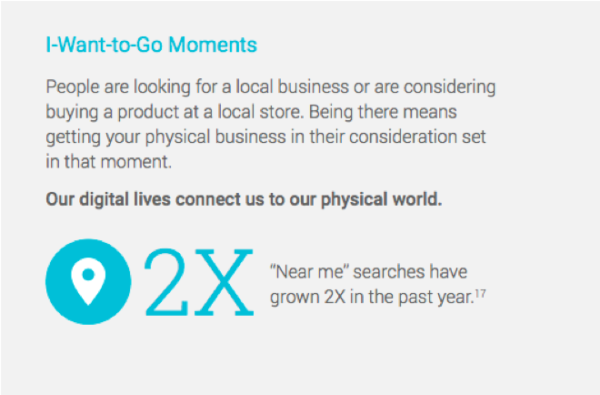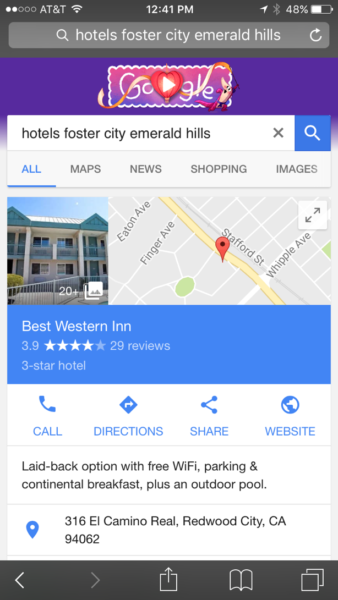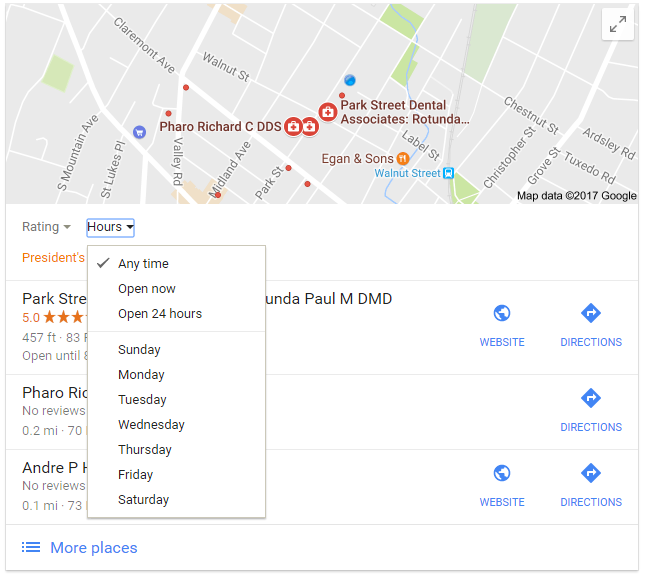Hyperlocal marketing will soar in 2017: 5 tips to stay on top
As mobile continues to grow, consumers are conducting more searches with hyperlocal intent -- and Google is refining its results in response to this trend. Columnist Jim Yu explains how local businesses can optimize for this hyperlocal reality.

The conversation about local search is not a new one; marketers have been discussing the importance of targeting customers by location for the past decade. Recently, it has been pushed back into the industry forefront with the rise of hyperlocal search and its relationship to mobile. Google Trends clearly show a dramatic increase in “near me” queries, particularly since mid-2015.
Hyperlocal targeting, or marketing to customers within your area based upon their location, has the potential to help brands answer the immediate needs of their prospects. Understanding how to optimize your content for these users can provide brands with an excellent opportunity for success.
Google has also been showing signs of pushing people toward hyperlocal. Back in 2016, Barry Schwartz reported a noticeable reduction in the number of pages offered for Google Maps search results, suggesting an effort to narrow the results down to a smaller geographic area. Google wants to better serve users by personalizing their results based upon their exact location.
Brands that do not prepare for the impending hyperlocal trends may end up seeing a considerable drop in both online and in-person traffic. According to retailers, as many as 82 percent of customers research online before making a purchase, which includes those who end up making a purchase in-store.
A poor online presence can harm a brand’s reputation and visibility, thus hindering business growth. Understanding the rise of hyperlocal marketing will be an important key to business success in the near future.
The relationship between hyperlocal and mobile
The increased focus on hyperlocal results can in part be attributed to the explosion of growth in mobile adoption. Mobile searches surpassed desktop back in 2015, and usage has only continued to grow. At the same time, our understanding of the user’s intent — and the impact of the digital ecosystem and mobile devices on the buyer’s journey — has improved.
It is important to note here that the buyer’s journey is no longer a linear path of relatively predictable steps that consumers follow until they make a purchase. Instead, this path has been shattered into a series of high-intent touch points that users may hit in any order, on a variety of devices, before they convert. For brands to reach customers during these high-interest points, they must be able to accurately interpret the user’s intent for particular keywords and queries, then design content that fits with that micro-moment.
Between 2014 and 2015, Google saw a 2x increase in “near me” and “nearby” searches, with 80 percent of those searches occurring on mobile devices. This indicates a rise in searches with hyperlocal intent, and Google refers to these searches as “I-Want-to-Go moments.”
The rise in searches indicating an “I-Want-to-Go” micro-moment also explains why the local 3-pack generally includes valuable information (such as the address, business hours and a “Directions” button) for those interested in making a trip to the location. A single click on the name of the business will also bring up more information, including user reviews. Google designs their search engine results pages (SERP) to have the optimal user experience, and this includes making it easy for people interested in contacting a business to accomplish their goal.
For brands to optimize for this micro-moment, they must similarly consider the needs and understand the intent of customers interested in going to or contacting a business. This means adopting a mobile-first mindset, which includes using mobile-friendly site design, keeping contact information prominently featured and including click-to-call buttons. The more you work to understand the needs of your mobile user, the easier it will be to draw local traffic.
Let’s look at an example of hyperlocal mobile listings in Google. When searching for hotels in Foster City, Calif., we see mobile results that display up to four ads, followed by the local 3-pack, which includes a map and three listings. Within the local pack, Google is displaying filters, such as “Deals” or “Cheap,” to help guide the audience to refine their queries. There is also the ability to select check-in dates for availability, and the listings themselves display pricing and reviews.
These features provide opportunities for marketers to refine and match content to searcher intent, which will factor into how you optimize your content pages and your Google My Business Page. (I discuss these options further in the Tips section below.)
Notice that when we refine the search query to a specific part of Foster City (Emerald Hills), the search results become “hyperfocused” on the business results. A search for “hotels foster city emerald hills” gives us the only hotel in the area. A map is also provided, along with “in Google” options to get more information. Four call-to-action buttons (call, directions, share, website), along with the address and business overview, are all prominently displayed, driving the audience to further engage.
What follows are five tips to succeed with hyperlocal marketing.
1. Master the basics
For your marketing strategy to succeed, you need to make sure that you have your Google My Business page ready and optimized. Fill out every field relevant to your business, ensure that your page has high-quality and appealing pictures, and verify that your businesses is listed in all the correct categories within Google.
Remember, every element added into your Google My Business page can provide important signals to assist with hyperlocal ranking and audience targeting. Your Google profile will determine how your business appears on the local 3-pack, so each step that boosts the appeal of your organization’s page will be beneficial. Encourage past satisfied customers to leave reviews to improve your business’s reputation and increase the positioning within the Google 3-pack.
2. Focus on your city and things of interest in that area
Develop localized website content that would interest people in your area. If you run a restaurant in San Mateo, for example, your site should focus on issues related to food lovers in the area rather than general information that would interest people everywhere.
Your content can also focus on local points of interest, such as landmarks and destinations, that people might use when looking around the area. For example, in Washington, D.C., people might search for “restaurants near the White House.” This can boost your geolocation targeting and help your business sound more appealing to those looking around a particular area.
3. If you have multiple locations, create local landing pages for each
To maximize your appearance in search, you want to have a local landing page for each of your destinations. This will allow you to optimize the content for each place and develop content that is more personalized for customers in that specific area.
Use keywords related to your location, such as the name of your city or your ZIP code. Do keyword research to find which words are applicable to your business and would be the most beneficial. Optimizing your local landing pages for these keywords can help draw in more traffic.
4. Include any structured data markup that relates to your business on your content pages
In order to provide Google with as much information as possible about your business, you may want to consider incorporating structured data markup (also known as schema markup) on your website pages where appropriate. Using structured data markup, you can precisely define various business attributes, including business type, hours, address, latitude and longitude, phone number and more.
Although Google may be able to glean this information simply by crawling your content, there is some degree of guesswork involved in doing so. With structured data markup, you remove that guesswork and make it clear to Google exactly what information is being presented on your page.
With your data properly marked up, it becomes easier for your business to appear for relevant queries. Note that on both Google Maps and the local 3-pack, users are able to filter queries based on business hours — so you’ll want to define your business hours with markup to help ensure you’re eligible to appear in these filtered results.
If you have multiple locations, mark up each one with the appropriate markup to ensure that potential clients can find your location nearest to them.
5. Track your progress on a local level
Once you begin to optimize your content for hyperlocal targeting, you need to make sure that you track your progress within the right location. This means monitoring the local search engine results pages serving your particular area. It will do you little good to monitor clicks and ranks for “Italian restaurants near me” on a national scale, for example, when you just want to rank for the keyword in the Springfield, Illinois area.
Instead, track your keyword rankings at your location of choice. The closer you can get to your exact business location, the more accurate your information will be. Use this kind of data to gain insight into the online local search experience of your target audience. You can then use this insight to guide your strategy as you move forward.
Final thoughts
Hyperlocal search has begun to grow as local search and the I-Want-to-Go micro-moment rise to a prominent position within search engines and the minds of consumers. Incorporating these tips in your local strategy will establish your brand strongly within this space and position you well for success moving forward.
Contributing authors are invited to create content for Search Engine Land and are chosen for their expertise and contribution to the search community. Our contributors work under the oversight of the editorial staff and contributions are checked for quality and relevance to our readers. The opinions they express are their own.
Related stories
New on Search Engine Land



